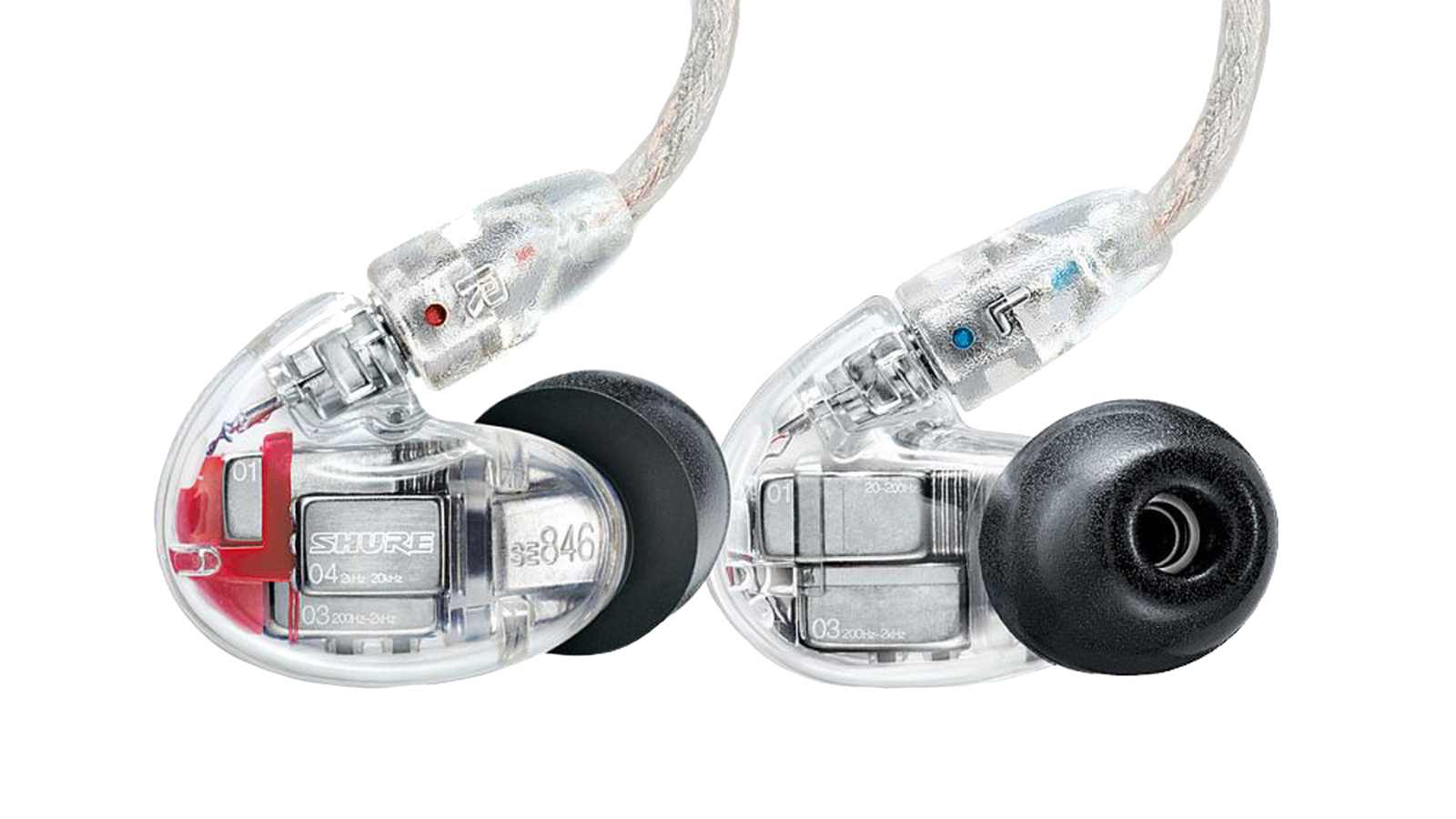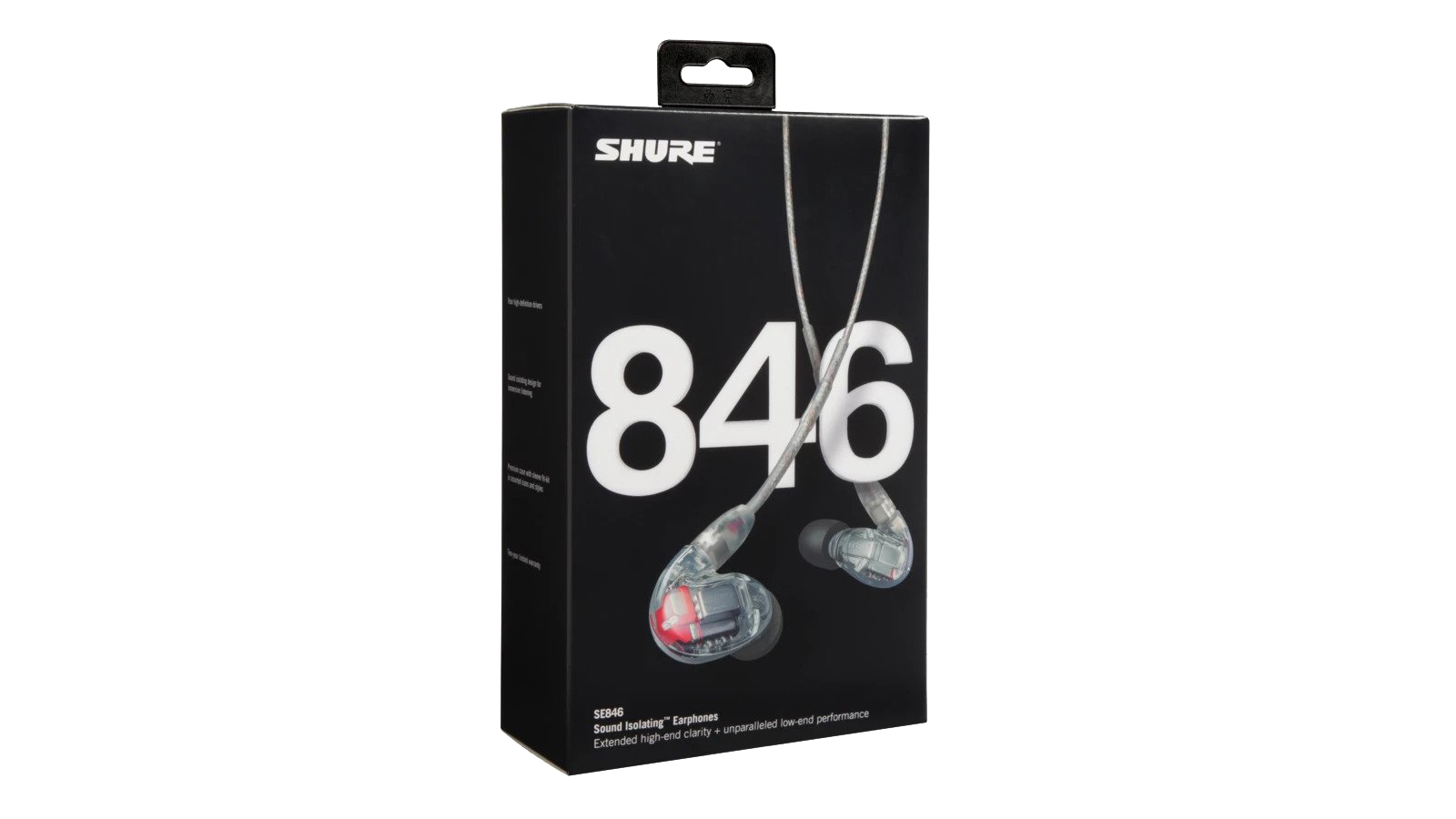MusicRadar Verdict
Delivering outstanding detail and clarity across the board, these top-of-the-line pro IEM's are some of the most capable earphones we’ve heard.
Pros
- +
Superb sound
- +
Quadruple high definition drivers
- +
Plenty of customisation options
Cons
- -
Expensive
- -
Bluetooth capability costs extra
MusicRadar's got your back
Shure SE846 Pro review: What is it?
Famous for the ubiquitous SM58 dynamic microphone that’s been practically a legal requirement centre-stage at live music venues for decades, Shure are one of the true pro audio heavyweights. The Shure SE846 Pro is their current flagship professional earphone with balanced armature drivers, aimed at music professionals and discerning domestic users alike - and it carries a price tag to match.
Unsurprisingly for such a premium-priced product, you get a lot of bits and bobs in the box. The packaging is suitably high-end, with a glossy, printed user guide, a Shure-branded polishing cloth plus a nifty little zip-up travel case. This ‘fit kit’ contains a spare detachable audio cable, soft flex sleeves and foam sleeves in three different sizes, a set of triple-flange sleeves, a 1/4” adapter, plus a tool kit for changing the nozzle inserts in order to adapt the frequency response.
The clear plastic earbud casing means that the sophisticated internal componentry is on display, giving them a purposeful, high-tech look, and the cables detach via a sturdy push-click fitting. Once attached, they are able to swivel through a full 360 degrees so that the ideal position can be achieved with a bit of fiddling about. The cable itself is stiff enough at the earbud end to retain its shape as you fold it over and behind the ear. As it stands, there’s no Bluetooth functionality with these, although this can be added by purchasing the BT2 Bluetooth cable or the True Wireless Secure Fit Adapter as optional extras.
If you’re one of those people that takes a while to - literally - get your head around a new pair of in-ear monitors, these won’t be the easiest to begin with. It’s not immediately obvious how to wear them, especially if you’re not that used to earbuds generally. There are no discernible L/R markings on the clear casing - we had to look at the picture in the user guide to figure out the correct orientation in the ear, not to mention which was the right bud and which was the left. (Clue: the red one goes in the right ear!)
Shure SE846 Pro review: Performance & verdict

Once we’d figured out which bud goes in which ear and which way up the cable exits need to be oriented (they need to be pointing at your temples), we found these to be actually pretty comfortable with the default pads. Even if they weren’t, there’s no shortage of alternative inserts available to swap and try - this kind of trial and error-based exploration period is, after all, part and parcel of any earphone experience, regardless of the level of sophistication - but the fact that we were able to get on so well with the default offering shows that Shure have done their homework on this aspect.
Under the hood you’ll find four high-definition drivers, splitting the audible frequency range into four distinct bands, one of which is a low-pass filter designed to deliver true subwoofer performance. According to Shure, this prevents the output of the low-frequency drivers interfering with the mid and high-frequency drivers, resulting in unparalleled performance across the range.
For tinkerers who are brave enough to partially dismantle and reassemble an expensive pair of earbuds for the sake of experimentation, there are three interchangeable filter inserts supplied - one fitted as standard for a balanced response, one for extra warmth and another for extra brightness - should you find the default sound not quite up to your expectations. Of the three, we favoured the default balanced option over the other two - although the warmth filter did sound luxuriously warm and smooth, the treble-boosting option proved a tad unforgiving for our tastes.
Want all the hottest music and gear news, reviews, deals, features and more, direct to your inbox? Sign up here.
The SE846’s feature unusually low impedance for a professional product - only 9Ω - so you really don’t need to drive these hard at all. In our tests with a 2019 MacBook Pro, setting the volume control around a third of the way up was enough to deliver ample levels of loudness.
So the big question is, do they sound good enough to warrant the extra outlay over and above other IEM’s costing hundreds less? Perceived value is always a contentious issue with high-end in-ears - they rarely appear visually distinct from much cheaper alternatives, so the air of luxury is usually not so apparent. This makes the elevated price point for the SE846’s immediately harder to justify.
Sound-wise though, the SE846’s are truly superb
Sound-wise though, the SE846’s are truly superb, to the point where it’s difficult to find source material to do them justice. Sound isolation is excellent, but the really good news is the crystal-clear reproduction across the board with the standard nozzle assembly fitted. The immediate impression is a broadly flat response - firmly inserted with the required proper seal into the ear canal, there’s no woolly, over-pronounced bass, the low end instead coming across tight and punchy with just the right amount of presence in the subs. Mids are as clear and present as the danger in a Tom Clancy novel, and the highs are refined and detailed without being at all harsh. The soundstage is appropriately deep and wide for a set of pro-level IEM’s, making for a highly enjoyable listening experience whatever your musical tastes. The clarity is outstanding and we found them equally as satisfying listening to classical and jazz as we did EDM and mainstream pop.
Those four high-def drivers cope admirably with any genre, revealing the rise and fall of the damper pedal in Ludovico Einaudi’s ‘Le Onde’. The individual instrument parts in Donald Fagen’s I.G.Y. have never been more discernible to our ears. Green Day’s ‘American Idiot’ has never sounded more ballsy and Pendulum’s ‘The Island Part II’ got us one step closer to understanding how Rob Swire pulled off those insane programming tricks.

The SE846 Pros proved especially revealing when monitoring our own tracks however, highlighting their appeal as a studio monitoring solution - trial mixes produced on these translated particularly well to other systems, which is a big tick in the box if you’re a music producer.
If you’re committing to this level of investment, you need a product you can trust, and the SE846 Pros deliver in spades in this regard, providing a beautifully balanced sound with excellent low-frequency performance and customisable high-mid response. With the reassurance and reputation for durability that comes with the Shure name, these make for a comfortable, well-built and superb-sounding investment that your ears will Shurely thank you for.
Shure SE846 Pro review: Hands-on demos
Brandon Taylor
Unbox Therapy
Austin Burcham
Shure SE846 Pro review: Specifications
- Type: In-ear monitor
- Driver type: Quadruple high-definition balanced armature
- Impedance: 9Ω
- Sensitivity: 114dB/mW
- Frequency Response: 15Hz - 20kHz
- Cords: 1.2m + 1.6m, detachable
- Weight: 12g (excluding cable)
- Contact: Shure
Dave has been making music with computers since 1988 and his engineering, programming and keyboard-playing has featured on recordings by artists including George Michael, Kylie and Gary Barlow. A music technology writer since 2007, he’s Computer Music’s long-serving songwriting and music theory columnist, iCreate magazine’s resident Logic Pro expert and a regular contributor to MusicRadar and Attack Magazine. He also lectures on synthesis at Leeds Conservatoire of Music and is the author of Avid Pro Tools Basics.





